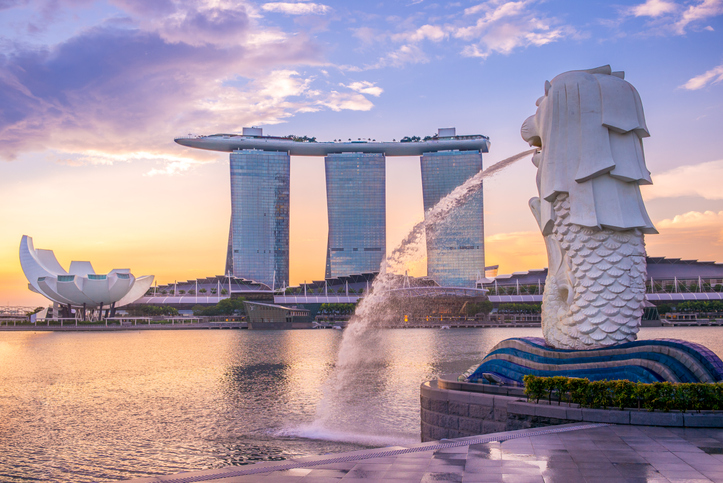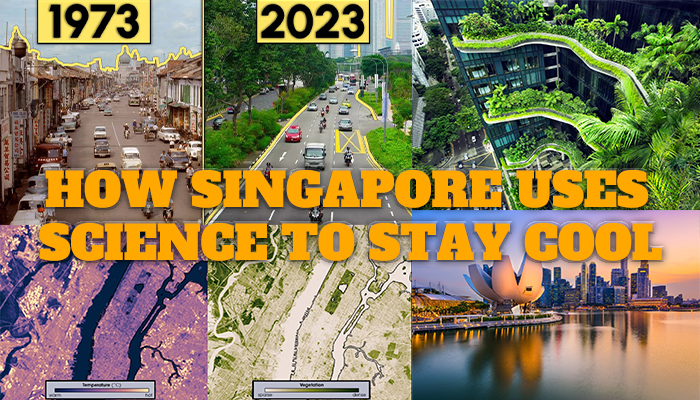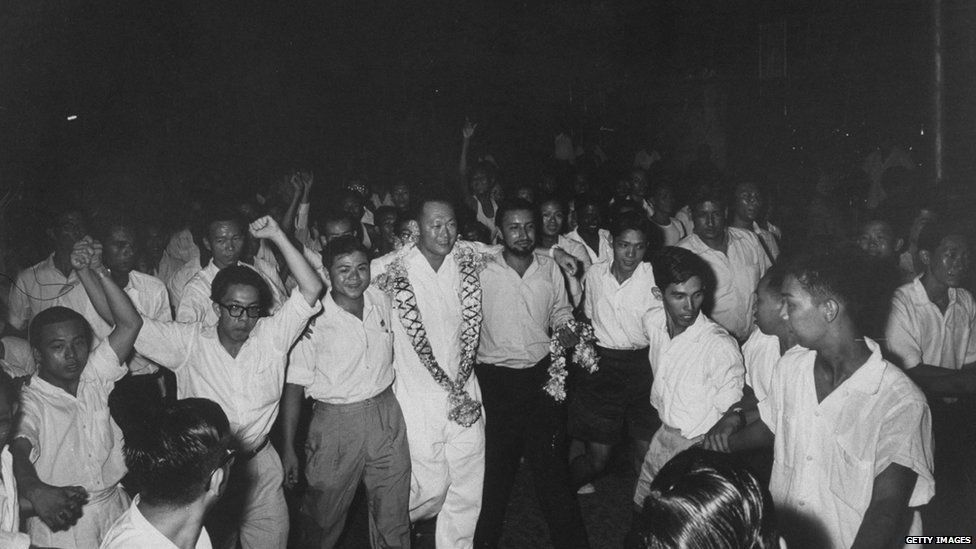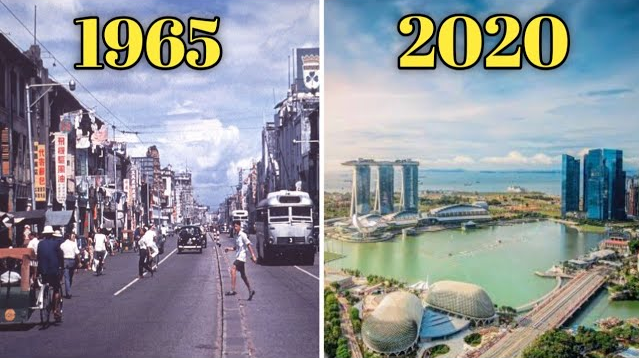Heat waves kill more people than any other extreme weather event: more than tornados, hurricanes, and even floods. That’s why scientists are coming up with novel, new designs to help keep temperatures down in Singapore. Read and fulfill your knowledge about How Singapore Uses Science to Stay Cool.
If you look at a thermal image of a city and then compare that to a map of vegetation, you’ll find that where there’s greenery, the temperature is lower.
That’s because things like asphalt, concrete and shingled roofs absorb more heat from the sun than trees. This is the urban heat island effect, and it accounts for the higher temperatures in cities, often by several degrees compared with their surroundings. It’s becoming a huge risk to human health as growing urban populations exacerbate the heating effects of climate change.
Heat waves kill more people than any other extreme weather event, more than tornadoes, hurricanes and even floods. That’s why urban heat island mitigation strategies are being studied in Singapore by a group of researchers. The government-backed project called Cooling Singapore is now in the process of combining everything they’ve learned to create a digital tool that can help cities all over the world, starting with Singapore.
Cooling Singapore
Let’s look at How Singapore Uses Science to Stay Cool In Singapore, close to the equator, temperatures regularly rise above 32 degrees Celsius or 90 degrees Fahrenheit. And the city structures only make it worse.
And that is also the case for Singapore, which is basically a concrete jungle, more urbanized, more developed city. And even in Singapore, what you have is a situation whereby there’s a temperature difference of 7 degrees Celsius between the more urbanized and the more rural areas.
The government has taken drastic steps to keep temperatures down. This is Gardens by the Bay, an award-winning park. And inside this greenhouse, it’s a pleasant 24 degrees. That’s because the dome, along with two dozen nearby towers full of thousands of people, is chilled by what’s probably the world’s largest underground district cooling system.
It uses a large central plant that cools the water and then pipes it into banks, residential towers, an exhibition center, shopping malls and the city’s iconic Marina Bay Sands hotel and casino complex.
One of the biggest perks of using this system for the buildings is that they can save 40% in terms of electricity usage compared to your traditional air conditioners.
And with Singapore relying on natural gas for most of its power, this new system means emissions savings equivalent to removing 10,000 cars from the city’s roads. That has big implications for the rest of the world. If things stay as they are, more than a third of the world’s electricity could end up being used to cool buildings and vehicles by 2050.
As the world gets hotter, gets warmer, there is a greater need for air conditioning and as well as refrigerators, for instance. And the more people are buying these household appliances, the more energy usage they use and they release heat more, and that then exacerbates climate change. It’s a vicious circle.
Vegetation
Since 2017, researchers at Cooling Singapore have been identifying design solutions that reduce our need for so much cool air in the first place.
Prof.Gerhard Schmitt (Lead Principal Investigator, Cooling Singapore) – “One thing many cities have in common, and that’s the importance of vegetation. That’s a very important measure to mitigate the urban heat because of the shading effect, of course, and the deep psychological effects of the vegetation. And also because of the possible evaporative cooling effect of the vegetation.
Vegetation can be, of course, on the ground floor in the form of trees and shrubs. And you can walk under them. This is the so-called canopy layer that the vegetation forms above us. But vegetation can also go up the facades of buildings and it can go to the roof of the buildings”.
Garden City Feel
Luckily, Singapore has been striving for the Garden City feel for quite some time. It was a vision initially introduced by then-Prime Minister Lee Kuan Yew in 1967 to make life more pleasant for people. And today, Singapore is one of the world’s greenest cities in terms of urban vegetation.
Kampung Admiralty, a community center that contains health facilities and social spaces, now provides more green space than the plot of land it was originally built on. It’s topped by a roofscape of staggered terraces covered in local plants, which functions as a community park, and a village green in the center that contains farm plots for residents to tend to.
Parkroyal on Pickering was designed as a hotel in a garden that doubled the green-growing potential of its site. There are now 15,000 meters of sky gardens, reflecting pools, waterfalls, planter terraces and green walls. And the government has big plans as well.
Singapore actually has a plan to plant 1 million trees and add more green spaces over the next 10 years. It is actually a mix of one thing to reduce the urban heat island effect. But on the other hand, it’s also to get people to be more connected to nature.
But it’s not enough. Heat MitigationThe city-state has still been warming twice as quickly as the world average over the past six decades. That’s why Cooling Singapore has developed a catalog of other potential heat-mitigation measures.
Prof.Gerhard Schmitt (Lead Principal Investigator, Cooling Singapore) – “When you try to mitigate the urban heat island effect in a city or in any building, in a village as well, the first place to start is by shading of the windows. You have to keep areas clear so that the wind can move through it. The water of a certain depth can act as a very good thermal buffer.
If you have to construct heavy buildings, such as high rises, at least you can make the surface, and the facade less heavy. And you can protect it from direct sun penetration. We have to make sure that no combustion engines will be in the city in the middle, in the medium- to long-term range. So ideally, the electricity production is outside of the city. And you bring just clean electricity into the city.
You can at least minimize the use of energy in the city. And you can start to slowly convert the roofs, the facades of the city, into production areas for renewable energy. In Singapore, unfortunately, this is a limited option. But in the long run, it could produce up to 20%, 25% of the energy, of the electricity needed in Singapore. If all the roofs and the areas in the buildings, on the buildings, on the facades would be used to do that”.
Urban Climate Twin
With so many different ideas, Cooling Singapore is also designing a virtual model of the city to test them out. It’s called a Digital Urban Climate Twin, or DUCT, that will calculate how each element of the city’s design will impact the urban heat island effect.
Prof.Gerhard Schmitt (Lead Principal Investigator, Cooling Singapore) –“That means we model not only the geometry of the buildings digitally, but also we model the transportation, the insulation, the temperature, the radiation coming from the sun, the weather, the local weather, the local climate, the even very, very microclimate of the city, the water, the movement of people in the city.
We can invent scenarios. We can design scenarios, test them before we actually build them. And if they test very well and we are sure that they will function, then we can start to build them and put them into reality”.
Conclusion
Singapore will be using this new tool to figure out which actions it should take next. And the model can be applied to any city, whether it needs to keep heat out or keep heat in, which will ultimately save energy, slow climate change and improve our quality of life.
So this is something that Singapore will be able to export, maybe even together with its city development systems that it already has. Singapore is one of the very few cities in the world that really combined this scientific approach with a very well-established urban redesign and urban design approach. Through its agencies and the combination of its agencies, it has achieved a lot in the past. If it keeps following the scientific path and combination with the other knowledge in the city already, we think that it will be a very comfortable and very livable city in the future, even more than today.

This was an intriguing depiction of how future cities all around the world might become greener, more energy efficient, and better to live in. We hope you enjoy this article about How Singapore Uses Science to Stay Cool. Please share, comment, and pin. Anyone can use our article ‘How Singapore Uses Science to Stay Cool’ for studies things.
Knowledge World Blog- WWW.KNOWLEDGEWORLD.BLOG
Visit Our Online Shop Website- WWW.CEYLEBRITY.COM
Ceylebrity Sinhala News- WWW.CEYLEBRITYNEWS.LK
Share























